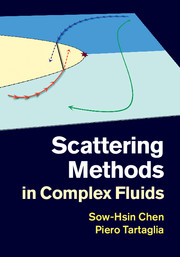3 - Aggregation and cluster formation
from Part I - Scattering and liquids
Published online by Cambridge University Press: 05 May 2015
Summary
Introduction
Interactions between particles, both in molecular fluids and colloidal systems, are generally characterised by a strong short-range repulsion, which is responsible for excluded volume effects, followed by an attraction of variable strength. The latter is at the origin of cluster formation, a process that produces many different physical phenomena of great importance in the physics of simple and complex fluids. In atomic and molecular systems the most relevant effect of attraction is the appearance of critical points accompanying phase transitions, while in complex fluids, besides critical effects, peculiar phenomena develop such as aggregation, percolation, glass and sol–gel transitions. Recently the latter have been collectively named arrest phenomena, since their common feature is the pronounced slowing down of the dynamics. We first outline briefly the phenomenology and the approaches based on aggregation and percolation, which describe situations in which the attractive interaction is so strong that the colloidal particles adhere, leading to the formation of macroscopic clusters that eventually invade the physical sample. In the case of reversible aggregation the particles form the so-called physical gels. When the aggregation is irreversible, chemical gels are formed.
Thanks to the possibility of forming reversible or irreversible reactive links, during aggregation clusters of particles tend to coalesce and form larger aggregates. In the case of reversible bond formation a fragmentation process is also present. Aggregation is an ubiquitous process that can be observed in disparate situations at various length and time scales. Examples are polymer chemistry, aerosol systems, cloud physics, clusters of galaxies in astrophysics, etc. Although aggregation in colloidal suspensions has long been studied, it has become a subject of renewed interest in recent years because it is a non-equilibrium phenomenon, the final stage of which may lead, among other things, to the formation of a gel. We briefly summarise various aspects of clustering by introducing the Smoluchowski aggregation formalism, which is used in many different physical approaches to aggregation, and a brief summary of the salient aspects of percolation that are important for the physical phenomena we describe.
- Type
- Chapter
- Information
- Scattering Methods in Complex Fluids , pp. 88 - 124Publisher: Cambridge University PressPrint publication year: 2015



